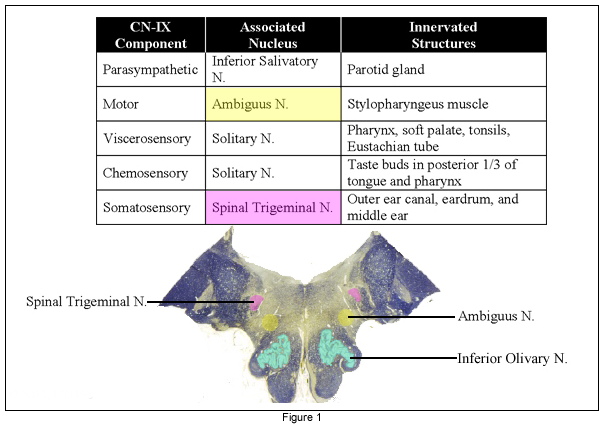Lab 9 (ƒ 10) - Cranial Nerve Nuclei and Brain Stem Circulation
Cranial Nerve IX - Glossopharyngeal Nerve
The components of the Glossopharyngeal Nerve include:
- The parasympathetic (preganglionic) fibers from the inferior salivatory nucleus terminate in a parasympathetic (otic) ganglion located near the parotid gland.
- Motor fibers of the nucleus ambiguus travel in the glossopharyngeal nerve to innervate the stylopharyngeus muscle.
- Viscerosensory fibers innervate the pharynx, soft palate, tonsils, and eustachian tube and end in the nucleus solitarius.
- Somatosensory fibers innervate the outer ear canal, eardrum, and middle ear and end in the spinal trigeminal nucleus.
- Chemosensory fibers innervate taste buds in the posterior third of the tongue and the pharynx and end in the rostral (gustatory) component of the nucleus solitarius.
 The inferior Salivatory nucleus is too small to be seen here, but is located superior to the solitary tract. The axons of the inferior salivatory nucleus travel in the glossopharyngeal (IX) nerve as parasympathetic efferents and synapse in the otic ganglion. The postganglionic axons of the otic ganglion innervate the parotid gland. Damage to the lower motor neurons results in the impairment of salivary production.
The inferior Salivatory nucleus is too small to be seen here, but is located superior to the solitary tract. The axons of the inferior salivatory nucleus travel in the glossopharyngeal (IX) nerve as parasympathetic efferents and synapse in the otic ganglion. The postganglionic axons of the otic ganglion innervate the parotid gland. Damage to the lower motor neurons results in the impairment of salivary production.
At this level of the medulla (pontomedullary junction) the ambiguus nucleus is difficult to see.
Lesions of the glossopharyngeal nerve would result in loss of the pharyngeal (gag) reflex because the glossopharyngeal nerve contains somatosensory afferents innervating the pharynx. Section of the nerve would interfere with the afferent limb of the reflex arc.
Lesions would also result in the loss of the carotid sinus reflex because the glossopharyngeal nerve carries viscerosensory afferents innervating the carotid body and sinus.
Sensory loss would also follow section of the glossopharyngeal nerve. Gustatory input from the posterior 1/3 of the tongue and pharynx as well as somatosensory input from the outer ear, tympanic membrane and middle ear would be affected.
Clinical Testing of Cranial Nerves IX and X:
- Ask to say “ahhh” to check uvula elevation - Cranial nerve X (motor)
- Ask to say “ahhh” to check constriction of posterior pharyngeal wall Cranial nerve IX (motor)
- Stroke left or right pharynx to elicit gag reflex - Cranial nerve IX (viscerosensory) and Cranial X (motor)
- Check for taste on posterior tongue - Cranial nerve IX (chemosensory)
- Press over carotid sinus to elicit reflex slowing of heart and drop in blood pressure - Cranial nerve IX (viscerosensory) and Cranial X (motor)
